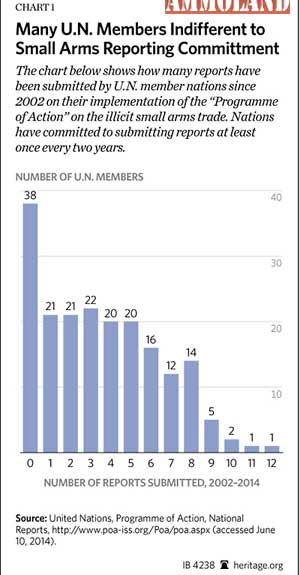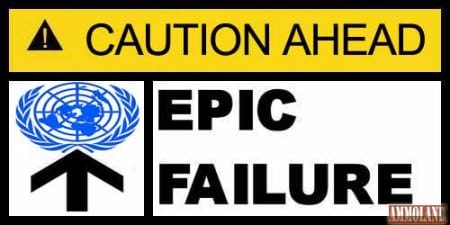U.S. Participation in the U.N.’s “Programme of Action” on Small Arms and Light Weapons Is Not in the National Interest ( This article first published on Heritage.org )
By Ted R. Bromund, Ph.D.

Washington, DC –-(Ammoland.com)- The fifth biennial meeting of the U.N. “Programme of Action to Prevent, Combat, and Eradicate the Illicit Trade in Small Arms and Light Weapons in All Its Aspects” (PoA) will be held on June 16–20, 2014.
The PoA includes a range of commitments on which participating nations have agreed to report. It is not a treaty but, in theory, a mechanism for encouraging voluntary cooperation.
In practice, the PoA has achieved little. But it is dangerous nonetheless. It is becoming a mechanism for promoting norms on gun control through the U.N. system, including the U.N. Arms Trade Treaty, which, like many other U.N. instruments, has no genuine connection to the PoA. The U.S. has nothing to gain and much to lose from continuing to participate in the PoA.
The Cross-Contaminating Structure of the PoA
The PoA’s structure is complex and poorly defined. The U.N. describes it as providing the “framework” for activities to “counter the illicit [small arms] trade.” It works within the Coordinating Action on Small Arms (CASA) mechanism within the U.N. and is closely associated with U.N. instruments such as the U.N. Register of Conventional Arms, the U.N. Convention Against Transnational Organized Crime, its Firearms Protocol, and the International Tracing Instrument (ITI), though only the ITI was created within the PoA framework.[1]
CASA, in turn, promotes a range of collaborative initiatives to support the implementation of the PoA and the U.N. instruments associated with it. In particular, CASA has embarked on the development of International Small Arms Control Standards (ISACS), which “fit within the global framework” of the PoA, the other U.N. instruments, and the U.N. Arms Trade Treaty (ATT). The most controversial ISACS modules, including one on “controls over the access of civilians to small arms,” are still forthcoming.[2]
The PoA seeks to serve as a stewing pot for all U.N. activities related to the control of small arms. Most of these activities have no connection to the PoA, but when all of them are cooked together, cross-contamination is inevitable and, for gun-control activists, desirable. This is because, unlike the ATT, which is purportedly limited to international trade, the PoA includes national-level controls on firearms.

It is therefore an ideal venue for advancing national guidelines, standards, and best practices that can then be asserted to be necessary parts of other, unrelated U.N. instruments. For example, while the U.N. refers to ISACS as “voluntary standards,” it also claims that they are “internationally accepted” and provide “comprehensive guidance” to policymakers in implementing the ATT and the PoA.
In short, the PoA is a venue for the incorporation of gun control norms into the ATT and other U.N. instruments.
The Failure of the PoA
Apart from seeking to promote those norms, the PoA has achieved little. In 2008, the U.N. Secretary-General stated that the PoA’s results were not “substantive.” A 2012 survey by New Zealand’s permanent representative to the U.N. acknowledged that “it is almost impossible to acquire an accurate picture of Programme of Action implementation and effectiveness” and that “the results of those more limited assessments that have been undertaken have not been encouraging.”[3]
The failure of the PoA is evidenced by the lack of interest that many nations have shown in fulfilling their commitment to report biennially on their implementation of it. The U.N. reporting template is available online, but in spite of this easy access, the number of nations that have fulfilled this most basic of commitments is declining. Only 88 nations submitted reports in 2012–2013, properly in advance of the 2014 biennial meeting, as compared with 110 in 2008. From 2002 through 2014, 38 nations have yet to make a single report, and the median nation has made only three reports.[4]
Supporters also claim that the PoA coordinates foreign aid between donor and recipient nations. In theory, recipient nations should be motivated to participate in the PoA, because this might lead to receiving more money. But in the 2012 survey of “Matching Needs and Resources,” the U.N. reports that only 26 nations requested assistance and that these requests were for a total of only $21,180,794, including the Islamist dictatorship of Sudan’s request for $100,000 for a “gender-responsive public information campaign.”[5]
The Agenda of the 2014 Biennial Meeting
A week before the meeting, the U.N. has already published a third draft of its outcome. The meeting will focus on the physical security of stockpiles, developing the ITI, providing more foreign aid, promoting national reporting, and—inevitably—scheduling future meetings.[6] The initial draft, since deleted from the U.N. website, noted that discussions might include the “limitation of the supply of SALW [small arms and light weapons] only to Governments or to entities duly authorized by Governments.”
The U.S. working paper submitted in advance of the biennial meeting expresses concerns that the PoA and ITI will not remain within their proper scope, that the meeting will seek to promote undesirable new norms, that calls for additional foreign aid are unrealistic, that “in the absence of appropriate legal and institutional frameworks” aid will not be a panacea, that “repeating debates on controversial issues”—such as, implicitly, the Second Amendment—“is not productive,” and that the ATT has no bearing on the implementation of the PoA and the ITI.[7]
The U.S. paper thus strikes a welcome note of caution, though regrettably it does not condemn the cross-contamination of the PoA by ISACS. But it also points out that the most serious danger posed by the PoA is the result of the fact that many nations—and nongovernmental organizations—welcome this cross-contamination.
For example, Germany’s working paper calls for the inclusion of ammunition control in the PoA, applauds the use of ISACS, and asserts that the ATT is directly relevant to the PoA.[8] The Non-Aligned Movement—a group of 120 nations, including Iran—demands that the developed countries supply its members with “advanced radar systems” (supposedly to improve their border controls) and that the U.S. enact gun control.[9] Even the promotion of a “culture of peace,” which appeared on the initial draft of the meeting’s outcome and is actually a call for press censorship and political re-education, can find a place in the meeting.[10]
What the U.S. Should Do
The U.S. should already have withdrawn from the PoA. By continuing to participate, it gives credibility to a U.N. institution that does not deserve it.
But as it has decided to participate in the 2014 biennial meeting, Congress should press the Administration to:
- Reject any efforts to transform the PoA into a legally binding treaty;
- Rebuff calls for expanded aid programs;
- Flatly oppose all efforts to expand or muddy the scope of the PoA, especially for the purposes of including ammunition controls, discussing the ATT, or incorporating ISACS;
- State explicitly that it does not recognize ISACS as having any standing;
- Propose the end of all U.N. activities related to ISACS;
- After the 2014 meeting, and except for case-by-case participation in meetings of technical experts on particular subjects, withdraw from the PoA; and
- Propose the elimination of the U.N. mandate for the PoA.
Focus on the Real Problem
At the upcoming meeting, the U.S. should focus on the supposed purpose of the PoA, which is to promote voluntary cooperation to control illicit arms trafficking. It should emphasize that this illicit trade is the result not of the legal ownership of firearms in the U.S. but of the ill-governed nations and lawless dictatorships that make up a majority of the membership of the U.N. itself.
*Visit the original article for references shown in this report.
—Ted R. Bromund, PhD, is Senior Research Fellow in the Margaret Thatcher Center for Freedom, of the Kathryn and Shelby Cullom Davis Institute for National Security and Foreign Policy, at The Heritage Foundation. Sarah Neibart, an intern in the Davis Institute, assisted in the preparation of this report.
About Heritage Foundation
The Heritage Foundation is the top conservative think tank in the United States. Their blog starts your morning off right with “The Morning Bell,” a blogpost that brings you up to speed on current issues, and then updates you throughout the day on a variety of issues concerning conservatives. Visit: https://blog.heritage.org
About Ted R. Bromund, Ph.D.:
Ted R. Bromund studies and writes on British foreign and security policies and Anglo-American relations as senior research fellow in The Margaret Thatcher Center for Freedom. He also explains why America must defend and advance its unique leadership role in the world. Visit: https://blog.heritage.org/author/tbromund/ to read more.




Screw shooting them. Nuke the bastards!
Bring on the UN. We will shoot them down like dogs!!!
haven’t we had enough from the UN, which has always been anti-Amerikan? We contribute money we don’t have for our country to a bunch of bureaucrats that do anything and everything to Amerika. When the UN was organized, the communists got special previledges, and positions. Get Amerika out of the UN and the UN out of Amerika.